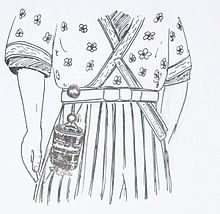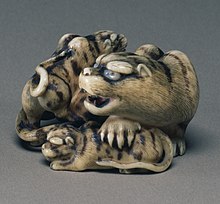
A netsuke (根付, [netsɯ̥ke]) is a miniature sculpture, originating in 17th century Japan. Initially a simply-carved button fastener on the cords of an inrō box, netsuke later developed into ornately sculpted objects of craftsmanship.[1]

A netsuke (根付, [netsɯ̥ke]) is a miniature sculpture, originating in 17th century Japan. Initially a simply-carved button fastener on the cords of an inrō box, netsuke later developed into ornately sculpted objects of craftsmanship.[1]

Traditionally, Japanese clothing – first the kosode and its later evolution, the kimono – did not have pockets. Though the sleeves of the kimono could be used to store small items, the men who wore kimono needed a larger and stronger container in which to store personal belongings, such as pipes, tobacco, money and seals, resulting in the development of containers known as sagemono, which were hung by cords from the robes' sashes (obi).
These containers may have been pouches or small woven baskets, but the most popular were crafted boxes (inrō) held shut by ojime, sliding beads on cords. Whatever the form of the container, the fastener which secured the cord at the top of the sash was a carved, button-like toggle called a netsuke. Netsuke, like inrō and ojime, evolved over time from being strictly utilitarian into objects of great artistic merit and an expression of extraordinary craftsmanship. Netsuke production was most popular during the Edo period (1603–1867).[1]
Netsuke and inrō declined as Japanese clothes were gradually westernized from the Meiji period (1868–1912). Because of their popularity amongst Western collectors at the time, some of the greatest collections are now found outside of Japan.[2]
Today, the production of netsuke continues, and some modern netsuke can command high prices in the UK, Europe, the USA, Japan and elsewhere. Inexpensive yet faithful reproductions are available in museums and souvenir shops.
The term netsuke is formed from the characters ne (根, meaning 'root') and tsuke (付, meaning 'attached').[citation needed] In American English, the word is usually italicized, while it is usually unitalicized in British English.[3][4][original research?]



Like many other art forms, netsuke reflect the nature of the society that produced them. This effect is particularly pronounced in netsuke, owing to long periods of isolation imposed both by geography and internal politics and limited avenues of self-expression for Japanese citizens due to custom and law.[9][10][11] As a result, netsuke display every aspect of Japanese culture, including its rich folklore and religion, crafts, trades, and professions, all types of people and creatures, both real and imagined, and every kind of object. As in other aspects of Japanese culture, the subjects portrayed by netsuke trend, over the long term, away from an initial emphasis on motifs of Chinese derivation toward a focus on objects of more strictly national interest.[12]
Some netsuke represent single, simple, objects, and some depict entire scenes from history, mythology, or literature.

Carvers of netsuke are called netsuke-shi. Sōken Kishō (装劍奇賞) is the earliest compilation of netsuke-shi, which lists over 50 netsuke masters. It was published in Osaka in 1781 by Inaba Tsūryū.[14] Some works of art are even illustrated in it.[15]
One of the most renowned artists during the Edo period was the founder of the Nagoya school, Tametaka (為隆), who is listed in the Sōken Kishō.[16] He was followed in Nagoya by Ikkan (一貫).[17] His pieces can be found in many collections and achieve high prices at auctions.[18]

The listed masters in the Sōken Kishō are:[19]
Seiyōdō Tomiharu (1733–1810) was founder of the Iwami school of carving.
The Metropolitan Museum of Art, the Los Angeles County Museum of Art, the Asian Art Museum of San Francisco, the Toledo Museum of Art,[20] the British Museum, and the Victoria and Albert Museum have many netsuke.[21]
In Kyoto, Japan, there is the Kyoto Seishu Netsuke Art Museum, which is the only netsuke specialized art museum in Japan. This museum is a traditional Japanese samurai residence built in the late Edo period. It has a collection of over 5,000 netsuke and 400 of them are on display and change every 3 months. The collection focuses on modern works, but there are also works from the Edo period.[22][23]
The Tokyo National Museum has a small exhibition room dedicated to displaying 50 of the 500 contemporary netsuke works collected by the Prince and Princess Takamado.[24] The Tokyo National Museum has 274 high quality items collected by Go Seinosuke (郷 誠之助, 1865–1942) and made by famous netsuke craftsmen from the Edo period to the Meiji period. They were donated by Go who was concerned that too many netsuke were exported from Japan and they were rarely seen in Japan.[25][21] To mark its 150 year anniversary, the Tokyo National Museum simultaneously exhibited all 274 works from the Go collection from November 2, 2022 to January 22, 2023 and all 500 works from the Prince Takamado collection from November 15, 2022 to December 25, 2022.[26][27]